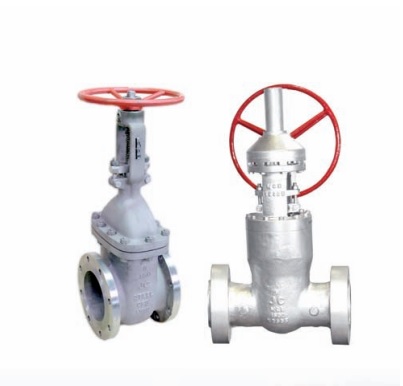GATE VALVES

Gate Valves Serve as efficient on-off valves with flow in either direction. In such a design, a wedge slide cross a general passageway in order to control fluid flow (like a sliding gate - hence, the name). One of the most significant characteristics of this type of valves is its straight-through, unobstructed passageway when set in the "full open" position. This is made possible by the wedge lifting entirely out of the passageway. As a result, gate valves are characterized by a minimum of turbulance and pressure drop in operation.
While gate valves are good for applications requiring these two factors, they are not recommended for installationsin which throttling would be a function. They are designed for on/off service.
• Body and Bonnet
Bodies and bonnets are high quality cast and afterwards precisely machined, directing the attention to prevent stress concentration.
The bodies of gate valves consist of a straight through port that guarantees minimal turbulence and resistance to flow. In both designs, bolted bonnet and pressure seal, the bodies consist of guide slots to accommodate the wedge during opening or closing of the valve.
Bonnets are made either of one piece only –the yoke then being an integral part of it– or have two pieces, depending on the size of the valve. This ensures the perfect alignment with the body what leads to an accurate opening and closing.
• Backseat
All JC gate and globe valves have backseat threaded in the bonnet, or for the pressure seal valves, welded to the bonnet. Into pressure seal the hard facing is stellite 6 or equivalent.
• Stem
The stems of JC gate valves are forged from one piece and ACME threaded, then mechanized and finally provided with a smooth finishing in order to minimize friction.
In gate valves, the union of stem and wedge shall be in T form, designed to prevent the stem disengaging itself from the wedge while being in service. This design includes a conical raised surface that presses the seat against the bonnet backseat in the fully open position.
Body and Bonnet Gaskets
The design of the body-bonnet/gaskets varies depending on the class of the valve.
Class 150 gate valves consist of a square joint in 2” and an oval one for all other sizes. Depending on the valve service it can be supplied flat-face gasket with graphite or PTFE.
Class 300 and 600 valves consist of a circular spiral wound gasket.
Class 900 and above gate valves consist of a ring type joint.
In pressure seal designs the sealing is achieved through a gasket that takes advantage of the internal pressure of the line. The material most commonly used is high-purity graphite being located between the body and the body retainer ring.
Flexible Wedge
All JC gate valves 3” and above valves feature a flexible wedge unless otherwise specified by the customer. The flexible wedge shifts along the body of the valve during opening and closing, being held in position by a guide slot that minimizes the friction between body seat and wedge. This design is especially suited to compensate slight thermal deformations produced by the pipe or the valve itself safeguarding a better sealing between body and wedge seats.